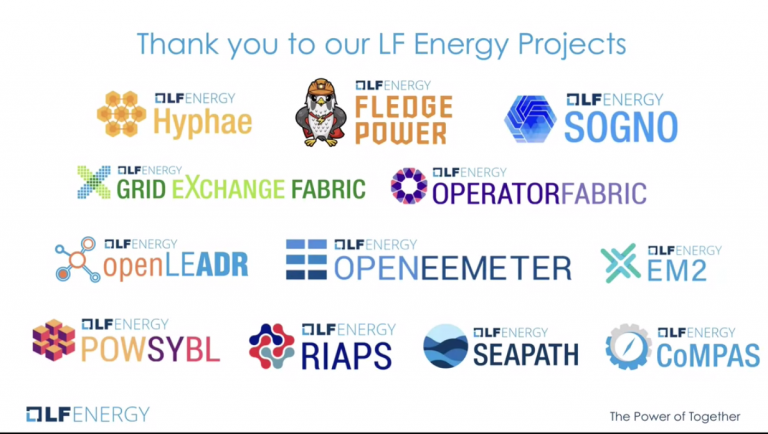Foundation for carbon neutral sustainability – LF Energy
This year I attended the LF Energy Spring Summit. While I was searching for open source, sustainability, energy awareness I found LF Energy, a sub-foundation of Linux Foundation that is focused on the power systems sector. I don´t need to introduce the Linux Foundation, but maybe not everybody knows LF Energy: “LF Energy brings together stakeholders to solve the complex, interconnected problems associated with the decarbonization of energy by using resilient, secure and flexible open source software. Digitalization facilitates a radically energy-efficient future. When every electron counts, renewable and distributed energy provides humanity with the tools to address climate change by decarbonizing the grid, powering the transition to e-mobility, and supporting the urbanization of world populations.”[1]
Fig. 1: In LF Energy several projects are gathered with the aim to achieve 100% decarbonization with sustainable open source technology.
I´m quite happy to live in Europe where topics like climate change, energy awareness, natural and mineral resources, future quality of life, are in a broader consciousness of governments and people. The European Union has signed the Green Deal and all countries make their own climate policies. And those forces organizations, companies, and enterprises to make the change as well, which gains recently in the signing of the Climate Neutral Data Center Pact by several European IT providers.[2]
But climate and energy are global concerns. The European approach is a great start, but we need to work on the goal that energy efficiency, carbon free energy, renewable power and sustainable energy infrastructure become the better options for all countries. Digitization is an important step towards this direction. But in most cases digital innovation and the change to digital infrastructure are expensive and accompanied by many fears – as changes always are.
But we need to talk about all the great opportunities and ideas which already exist. We need to use all possibilities to work jointly and collaboratively, to open source our code, to push forward digitization, and find new, sustainable, forward-looking, carbon free energy, and technical solutions. I love the fact that the great, global Linux Foundation thinks the same and took LF Energy under its roof!
After the summit I wanted to know more about the LF Energy and I had the great pleasure to meet Shuli Goodman, founder and executive director of LF Energy:
Please tell me about you and the LF Energy. How long are you part of The Linux Foundation, and what are you doing and why?
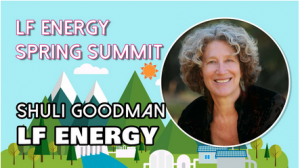
Just over four years ago, right after Trump was elected, I recognize that there was a tremendous opportunity, with regards to open source and building the common non-differentiating kind of infrastructure that is going to support the energy transition. And I went to The Linux Foundation, and I said I was looking for “Switzerland”.
They joked and said that’s often what people want. What I meant was that I wanted some place that was neutral, where we could put our code, and build the non-competing software plumbing that will power the energy systems of the future. I think at the heart of The Linux Foundation brand is the notion of precompetitive cooperation and precompetitive collaboration, being able to build the digital pipes that connect things that allow people to build on top of it. And I thought it was such an obvious idea that everybody was just going to go, yes, and then boom, it was just going to become like a big garden. But instead, I realized that it’s a very big project and that it has required a considerable amount of socializing the ideas about what is the benefit of open source, what’s the business case (fig. 2).
I began by looking for unicorns. All the early innovation is in Europe. And so, RTE[3] and Alliander[4] were the first unicorns and then TenneT[5] and Energinet[6]. It is through engagement of network operators and end-users that we can begin to define the common parts. The next challenge is how were we going to build this out and then sharing and communicating that message to the world.
I think that it’s going well, it’s slower than I imagined. But I am a gardener, and so I believe that if you keep tending you’ll succeed. Who’s to say how big this garden needs to be and so it’s just taking time, it’s a little bit before the market is how we would describe it. But I see now that there’s momentum that’s coming, and there is a convergence of things that is occurring, that is really central to our mission which is a kind of the intersection.
When I think of the building blocks of the power system network for the future, you have 5G and a kind of communication pipes that are going to allow for really a kind of instantaneous microsecond, millisecond of transactions. And then you’re going to have edge and distributed computing and cloud native. Which really is at the heart, because you can’t have a distributed energy without talking about distributed computing.
When I think about how to make the transition, I think at the core is economic. My background is innovation that’s what my PhD is about and so I take an economic definition of innovation, which is the ability to do more with less, and so I believe, if we can do more with less resources we will win this, and so my job is to create a kind of the commodity software that enables commodity hardware that enables the entire planet to become electrified and that’s how we think about it.
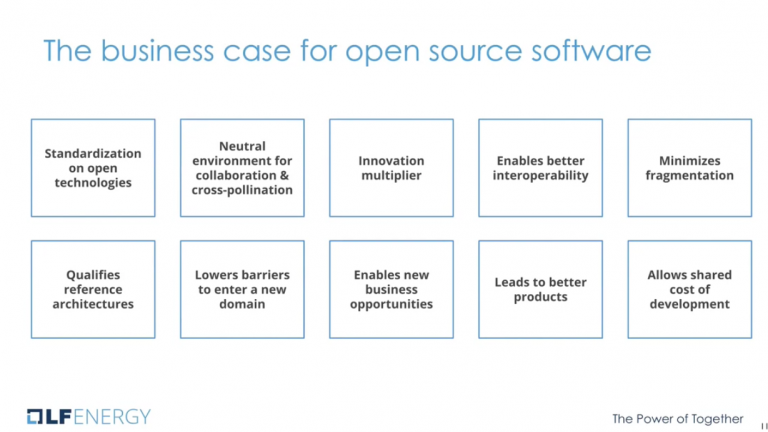
Fig. 2
Could you please summarize the goals of the LF Energy and why we should think this globally?
Well, our goal is 100% decarbonization. 75% of decarbonization need to come from our power system networks, transportation and the built environment. Our power system networks lead. Because you have to transform the power system networks by being able to manage massive quantities of data and then be able to choreograph and orchestrate that in order to manage and maintain grid stability. And to onboard increasing levels of renewables and intermittent low inertia energy.
So, we’re an open source foundation, we live inside of The Linux Foundation, our sister foundations are CNCF, LF Networking, LF Edge, Hyperledger, Automotive Grade Linux. All of these represent the core parts of the energy transition, and so it makes sense that you would put the foundation in The Linux Foundation.
I think another reason why we did that is because all of us have the experience of how challenging and difficult it is to work together with many different stakeholders and to be able to achieve outcomes. And one of the things that The Linux Foundation has demonstrated over and over and over again, is the ability to create environments. Where people actually can work together and collaborate and get things done.
I joke and say you know the Linux Kernel, the Linux operating system started in a dorm room in Finland and 30 years later, is the really the foundational operation system for the planet and there were no politicians involved, nobody got killed, there were no standing armies. It became foundational and the way that it happened was developer to developer to developer. People basically said, this is a project, I want to participate. And there’s a sense of agency that people have and a do-ocracy that if you’re good at what you do, you can participate and that it’s an ecosystem.
I look at it like a gardener which is, if you create the conditions, the thing will grow and so that’s what I’m doing. I’m building it on top of the intellectual property and the legal framework of The Linux Foundation. At the heart is the Linux Foundation DNA and the history of how all this software has gone from the edges to central in such a short time. Aside from the Kernel there’s also LF Networking where 70% of all mobile traffic goes over open source, Automotive Grade Linux: 60% of all automobile ship are sailing with AGL inside.
How can open source help to achieve carbon free energy on the planet?
Digitalization is what we do to build communication pathways between hardware and either controller orchestration or choreography software. We want to create the conditions for massive innovation and if there is only proprietary communication software, that creates vendor lock-in. We want interoperability, so that it we can drive scale and plug and play (fig. 3).
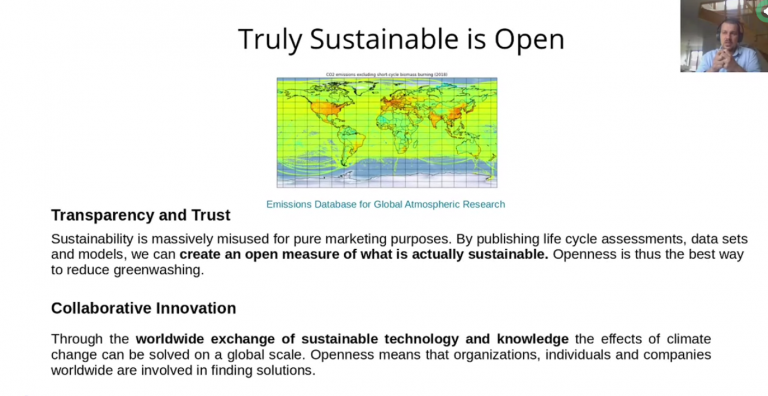
Fig. 3: Slide from Tobias Augspurger´s talk at LF Energy Spring Summit, founder of the open source project Protontypes[7]
For instance, when we first started the internet, we imagined certain things would happen that there was going to be a convergence of open source, there was going to be a convergence of telecommunications, media, computing. We didn’t imagine that we were going to have unlimited music, we were going to be able to completely document every single thing that ever happened in our lives, nor were we going to have access to shopping, research, and so on. We just never imagined it was going to be so transformative, but the reason why that happened was because, at the foundational level, the internet is built on standards and open source, and that open source enabled very rapid iteration and kind of mechanisms for innovation. And we want to do the same thing around energy and the energy transition.
As an example, AT&T believed in the transition from a kind of network operations and telecommunications, which was very hardware centric, that they were moving to 75% digitalization. And that’s probably a little hard for energy to imagine that we’re moving to 75% virtualization, because electrons need a physical path, a physical service in order to move, you can’t throw electrons through the air. So, we’re probably not going to get 75% virtualization, but I would imagine that perhaps we could go to a 50% software defined infrastructure which is not only about cost, it’s about time and resources.
But the reason why you do it is to create what I would refer to as radical energy efficiency so that every electron counts. Right now, we flick a switch and open the pipe up and just throw a lot of electrons at things. We want to become much more precise about how electrons flow. That requires digitalization, that requires metadata about the electron to choreograph it, orchestrate it, forecast it, plan it, understand the analytics of it.
To build markets that use price-based grid coordination, is a simple idea that uses price signal to communicate to the devices in our homes, businesses, and industry in order to drive behavior and usage based on availability and demand. To all the things that draw energy or create energy that this is the role they should be playing right now. We need flexibility to send signals to back off of our heat or our cooling or power down a refrigerator or don’t do the laundry right now, because we lack capacity. That’s actually a quite simple and elegant idea. It is difficult to execute though!
In some ways we will be creating what real live currency markets driven by electrons. That’s the direction that I think we’re going in and that open source is at the heart of it and digitalization is critical.
Just one more point, which is that we have found that in a more mature industry 80% of software will be open source and 20% is proprietary and built on top of all those open source parts. That’s really the rubric that we’re using so if 50% of the energy transition is digital and being able to coordinate and orchestrate hardware and then 80% of that software is going to be open source which would then suggest that 40% of the energy transition is open source and is figuring out how to bring all these pieces together to enable these markets that this opportunity, the energy transition to emerge. That that’s how I do the math (fig. 4).
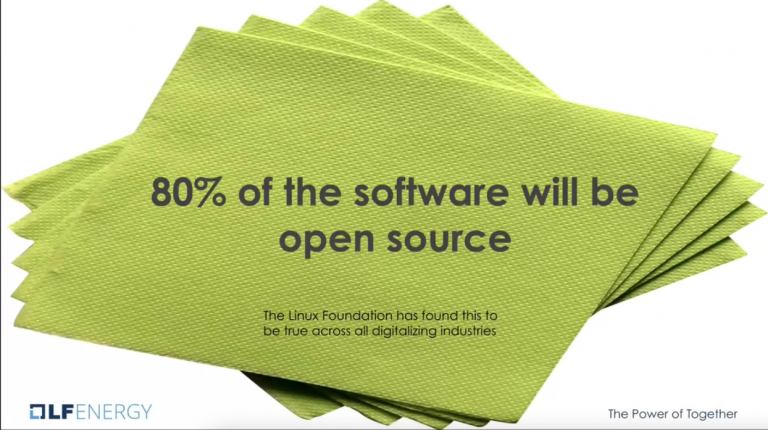
Fig. 4
Here in Europe we try to be aware of energy efficiency or carbon neutral energy, we have the Green Deal from the European Commission and the Climate Neutral Datacenter Pact from different cloud providers and so on. How can we spread the word to the world? Could you advise Europe to do more, to become a role model for the other continents?
My experience is that, right now, Europe is leading the world by making a declaration of commitment to decarbonization. I think that Europe has gone all-in recognizing that there is an economic transformation that’s going to take place and that can drive the transformation. This is policy and policies at best drive markets where actors like utilities receive those signals and begin to transform. Even if it seems frustrating or that it’s happening slowly, there is momentum and there is motion. We have to trust that momentum and put all our energy behind that momentum.
But you know it’s also to continue to create the conditions for those transformations to take place to get to 50% or 60% decarbonization in the next decade. I’m not saying it will be easy, but I think that it will be relatively easy compared to what it’s going to take for the second 50%. Looking back, these will be the easy years.
The remaining parts are going to become increasingly complex and are going to require increasing levels of cooperation amongst humans about what we do and what we’re willing to say we won’t do, so that becomes a social project. It really is going to require everybody to participate in those transformations.
The United States has been a very confused actor in this space. Our oil and gas industry had begun winding down and then fracking was developed and the US became one of the top three oil producing countries again. This created some powerful special interests and strange bedfellows. The US is not alone. Russia has very entrenched views. Without a diversified economy, Russia wants Europe to continue to buy its products because it has no other mechanisms for generating wealth. The odd vortex of the Trump years was the US working to collude with Russia to ensure slowing the energy transition down.
What we are trying to do with decarbonization is unbelievably complicated. In the US there are people who’ve been elected, right now, who have sobriety in terms of seeing what’s in front of us, but you have utilities and states that are in varying degrees of agreement about what to do. For instance, I recently was reading something about how Wyoming was going to sue state that won’t buy their coal anymore to bully us into buying their coal. So, there’s going to be a lot of that in the next 10 years.
In closing, one of the most important parts of LF Energy – and again I’m a gardener – I believe that you don’t plant the garden of the future in the garden of the past. There needs to be enough containment of the garden to protect the future as its emerging. I’m pretty confident from everything I know that the dominant paradigm will try and reassert itself and control the outcome. Partly I feel like LF Energy is in The Linux Foundation, because The Linux Foundation will protect it. And I will protect LF Energy.
Thank you and I´m very touched, because the environment, sustainability and the future are my heart topics. We need this transformation to gain future for our kids and the next generations.
Exactly. We really want the digital infrastructure companies to get involved with LF. We’re really in the beginning, there’s a leap of confidence that people have to make to say – “let’s do this work together, let’s work together inside of a community like LF Energy”. I trust that we will be able to be successful. It’s like a gathering of the tribe. There’s a very limited set of people who are going to do this, I mean everybody is going to get in get involved, because our lives are going to change, but from a technical perspective it’s a relatively small set of people.
We have to come together and just say “okay let’s do this here, this will protect our intellectual property, and this will help us get there”. Anything that you can do to get that message out, I would really appreciate.
I will do it with my heart.
Article and interview was conducted by Friederike Zelke.

[2] https://www.climateneutraldatacentre.net/
[3] https://www.rte-france.com/
[4] https://www.alliander.com/en/
[5] https://www.tennet.eu/#&panel1-1
[6] https://en.energinet.dk/
[7] https://github.com/protontypes

